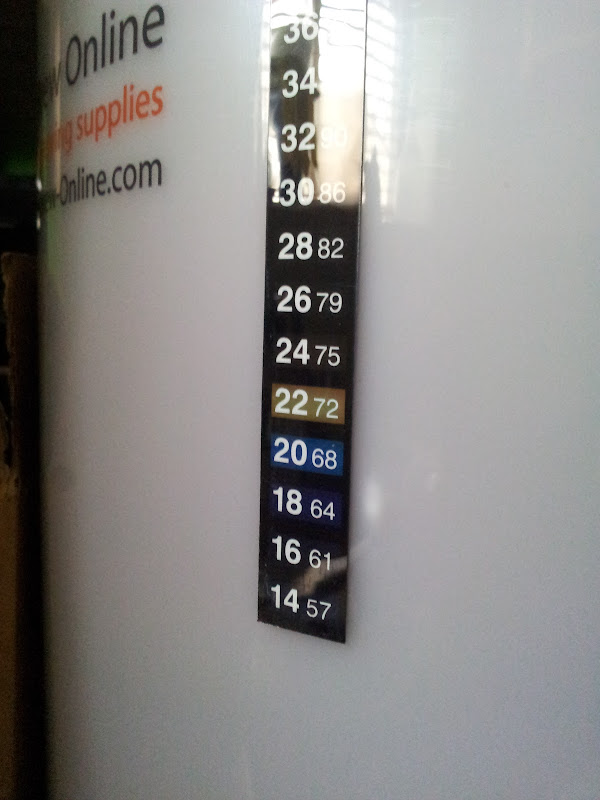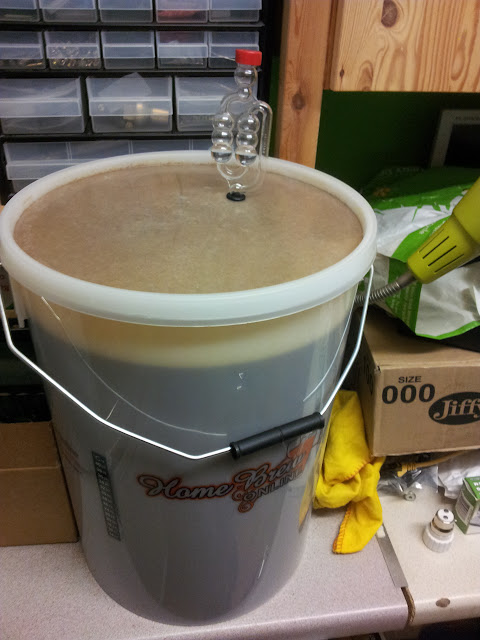First brew online..
Ok, i bought my kit with the norfolk NOG kit, i have sterilised everythingand got it going, it has now been 24hours and when i came home was pleased to it had frothed up, however, i am not getting bubbles through the airlock and i have watched it closley, i bought the heated tray with my kit but i dont think i am going to need it, i have the stick on thermometer and i think i may have more of a problem keeping it cool rather warmer..see what you think to the picture

I plan to use bottles for the summer as i can cool them and in the winter i will use the barrell, i had an idea for use of the barrell whilst not in use...when i had sterilised the fermenting vessell i syphoned the fluid into the barrell and added an extra teaspoon of steriliser and i intend to store it in the barrell keeping it sterilised, when i start my next batch i will use the fluid in the barrell to sterilise the fermenting vessell after cleaning...of course i will not over use it but is this a bad idea ?, the barrell will be getting stored in the dark so will not be sunject to light.
I have been reading about these spray malts and enhancers...should i worry about these on my first brew, my expectations are high i have to say ?
Is it ok to fill the trial jar for the hydrometer by dipping it into the brew ?..i will clean it with isopropyl alchohol before hand ?
The norfolk brew i have is very dark, how will i see where the sediment comes to ?
I dont fancy making a hole in my vessell to house the bottler..i would like to somehow attach a stiffening device to the syphon tube to allow my to have the entry point at a certain level on the inside on the vessell, when bottling if i just squeeze the tube when i need to tranfer it to another bottle will it continue after i let goes or will i need to suck on it again ?
I chose the NOG ale because i quite like the dark ales, winter warmer, christmas pudding, harveys etc etc..can i expect the same level of quality from my own brew ?
Thanks for looking in, no doubt ill have more questions to come, my main concern is this airlock not bubbling..should i worry ?

Categories
- All Categories
- 599 Home-Brew-Online Forum
- 233 Welcome To The Forum
- 34 News And Announcements
- 85 Frequently Asked Questions
- 229 General Home Brew Chat
- 11 Your Brewing Blogs
- 532 Beer
- 460 Beer Brewing
- 56 Beer Reviews
- 14 Beer Recipes
- 2 Beginners Video Guides
- 87 Cider
- 82 Cider Making
- 2 Cider Review
- 1 Cider Recipes
- 142 Wine, Liqueurs And Spirits
- 114 Wine Making
- 5 Wine Reviews
- 17 Spirits And Liqueur Making
- 6 Wines And Spirits Recipes
- 50 HBO Ebay Shop Queries
- 6 Queries About My Order
- 11 Returns Policy
- 17 Postage
- 6 Payment
- 9 Placing an order

Comments
It does vary on where you keep your brew when fermenting as to whether it needs help with temperature, it is not uncommon for people to use them throughout the year when keeping in cooler places, and help to keep fermentation times as quick as possible. From the amount of froth in your photos fementation is certainly taking place, so you have no need to worry about that problem. When they start vigorously this often slows down after a day or two, so just rely on your hydrometer readings for when to keg or bottle. We would not recommend storing a steriliser in a barrel or any other vessel for a long period of time, the instructions should always be followed, and it is important to thoroughly rinse with clean water to ensure no traces are left. Leaving it in a container could create problems, we would advise against this. Just sterilise equipment prior to use and rinse well.
Spraymalts and enhancers are there to add something extra to brews. It is no bad thing to start without, then you have a good understandng of what the brews are designed to be like by the manufacturers. With the Woodfordes range, which are 3kg (2 tin) kits, all the sugars and malts are already in there for the fermenting stage, you just need a small amount of sugar to prime the bottles/keg later when transferring over. There is nothing more you need to add. Spraymalts come in various styles, and can be used to add more flavour to your preference, perhaps more hoppy or darker, etc. The cheaper end of the range of beer kits will see the most benefit from using spraymalts and enhancers. They are used more commonly with 1kg (1 tin) kits.
When taking a sample in a trial jar, the trial jar should be cleaned in the same way as the rest of the equipment, and then can be used to scoop a small sample of brew out for testing. When syphoning try and keep the tube near the top of the fermenter (but always below the surface) so that minimal disturbance to the sediment is made, and then lower the ube down as the level drops so you are always syphoning from the furthest point to the sediment. You will leave some brew behind at the bottom, but this is allowed for by Woodfordes, and will mean clearer beer for the finished product. It in inevitable that some sediment willbe disturbed and get through but it is such a small amount compared to the volume of liquid it is nothing to worry about. By pinching the syphon tube closed, it will stop the flow, and then re-start when released as long as no air is being drawn in, it just takes a little practice. Several devices are available for syphoning, such as the auto syphon, and the pinch valve, which can make it easier. The airlock is there to stop anything contaminating the brew, it may bubble as gases froce their way out, but not always and depends on the pressure. If there is even the slightest hole or gap anywhere else the gases will escape there instead of moving the weight of water in the airlock, as they find the point of least resistance. Many people don't even bother with the airlock, and just loosely cover the fermenting vessel instead, even if the airlock is not bubbling we recommend you just leave it in there as any other hole will be so small the chances of contamination are so low, which is why people often choose to just loosely fit the lid. Many kits don't come with an airlock, they say to just crack the lid open slightly for this reason. The froth is a clear sign of fermentation going well, and your hydrometer readings will confirm the progress and when it is completed.
The final taste of the brew - well it is very tempting to sample early, and to drink it all early, whilst it will be good, always try to leave the beer as long as possible, as many weeks as you can - this allows it time to condition, the flavours always improve, people tell us this time and time again
i took the reading this evening, not really sure what to make of it as it doesnt seem to give any reading..
I made sure there were no air bubbles stuck to the side of the hydrometer, it was floating freely...also there was loads of foam gunk under the lid and around edge..should i wipe this away ?
I did notice there is now sediment at the bottom of the barrell, i could see the occasional buble errupting from it.
Hi Loady, that looks suspiciously like a 'alcoholmeter' and not a hydrometer, if that came in a kit for beer from us then it has been a mistake, just email us your details to sales@home-brew-online.co.uk order number, postcode, email etc, and we'll send you a hydrometer out straight away. If it is from something else then you will have a hydrometer in the kit. The alcoholmeter only works in spirits.
The bubbles still rising from the vessel are a sure sign it is still fermenting so give it another day or so before you check. The hydrometer reading needs to be around 1014 or lower, and no bubbles too for fermentation to be complete, especially if bottling as too much pressure in the bottles is not good.
Reducing and off setting your 'beer slipper footprint' is a good idea! There are many bottles available on the market, we only have clear PET 1 litre plastic bottles as they are not popular amongst beer drinkers, more commonly used for other drinks, but they are suitable as long as stored in a dark place, you would prime them with more sugar on a pro rata basis - if using say one carbonation drop per 500ml bottle, then as this is double the size use 2 carbonation drops per 1000ml bottle, etc.